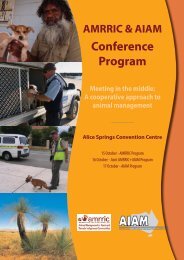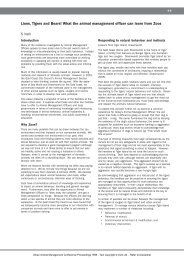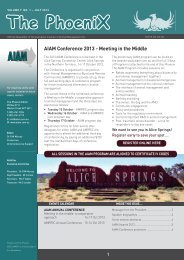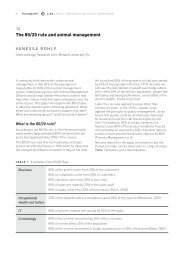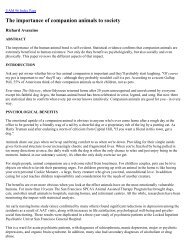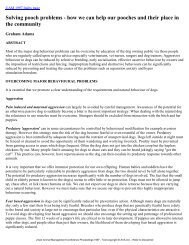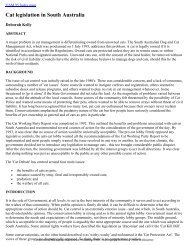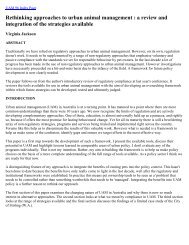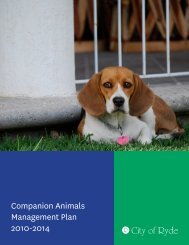Cat management for Magnetic Island - Australian Institute of Animal ...
Cat management for Magnetic Island - Australian Institute of Animal ...
Cat management for Magnetic Island - Australian Institute of Animal ...
You also want an ePaper? Increase the reach of your titles
YUMPU automatically turns print PDFs into web optimized ePapers that Google loves.
example, while farm livestock may not be allowed to wander onto roadways where they can cause traffic hazards andproperty damage, council <strong>of</strong>ficers do not go out inspecting farm fence lines and checking the adequacy <strong>of</strong> individualbrand identification on cattle, sheep and horses. It is left to the farmers to ensure these things are done properly orsuffer the consequences if they are not. This is self regulation.• A recording system <strong>for</strong> pet cat identification with associated owner linking does in fact lend itself to theconcept <strong>of</strong> community self regulation. With a community self regulation approach in this situation council staffdo not have to check cat registrations as they do <strong>for</strong> dogs. In other words, cats can be recorded by their ownersrather than registered.• The onus <strong>of</strong> identification is entirely on the owners, not only to do it but to do it right as well. It can quitesimply be made clear in the relevant local law that any impounded cat showing no <strong>for</strong>mal (approved)registration/identification will <strong>of</strong>ficially be classified as a stray and that will be that.• A requirement <strong>for</strong> the desexing <strong>of</strong> pet cats is another option that lends itself to a self regulatory approach. Thebest pathway is to utilise the power <strong>of</strong> neighbourhood peer group pressure backed up in the local law by arequirement that entire cats over the age <strong>of</strong> 5 months can only be kept by people who hold a breeder's permitand must under no circumstances be allowed by the permit holder to be at large at any time.v. Linking the keys - the microchip 'key ring'Microchip technology <strong>of</strong>fers the obvious solution to this problem. Provided an '<strong>Australian</strong> reader base' standard is usedmicrochips <strong>of</strong>fer a reliable, af<strong>for</strong>dable, available and nationally uni<strong>for</strong>m method <strong>of</strong> identification <strong>for</strong> cats.'<strong>Australian</strong> reader base' standard must be used.Provided the microchips can be obtained by local veterinarians with a standard collar, bell and appropriate educationalmaterial, the advantages <strong>for</strong> local government are as follows:• council does not have to be mixed up in owner record database <strong>management</strong> - it is up to the microchip supplierto log the details - it is up to the pet owner to ensure the records are current and accurate;• council animal control <strong>of</strong>ficers can access the database any time via a 008 phone number if the need to contactan owner should arise;• council does not have to be involved in the distribution and implantation <strong>of</strong> the ID device/s - it is up toveterinary practices to supply and implant the microchips;• council does not have to bill anybody - the ID, implanting and registration database services are all supplied ona competitive fee <strong>for</strong> service basis direct to the pet owning clients; and• the council takes advantage <strong>of</strong> a pet owner education service that accesses all the recorded pet cat owners at thetime the microchip is implanted without any input at all from the public sector.vi. Public notice summaryThe following guidelines <strong>for</strong> cat owners can be clear and simple and published regularly:• pet cats must be identified by microchip and both their own and their owner's details recorded accurately in themicrochip supplier's national pet records database;• standard residential property allows the keeping <strong>of</strong> up to 2 cats per residence with permit constraints applyingto flats, units and situations exceeding the standard 2 cat limit;• pet cat owners are encouraged to provide their cats with conventional collars, ID discs and bells;• pet cats must, by the time their permanent canine teeth have erupted, be either desexed or be registered asbreeders and kept according to the council's cat breeder permit requirements;• the owners <strong>of</strong> pet cats should minimise and may, if required, have to prevent their cats trespassing ontoadjoining property;• the feeding <strong>of</strong> stray cats is discouraged absolutely.Urban <strong>Animal</strong> Management Conference Proceedings 1997 - Text copyright © AVA Ltd - Refer to Disclaimer




